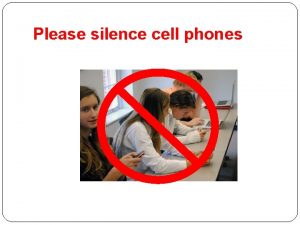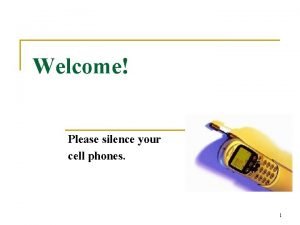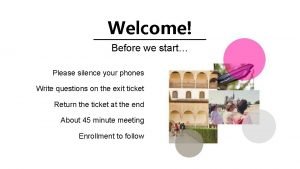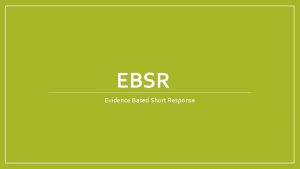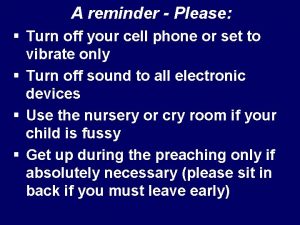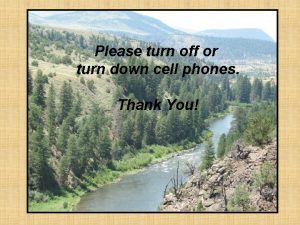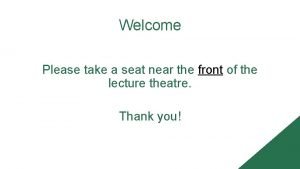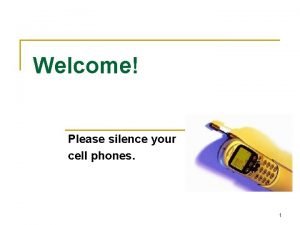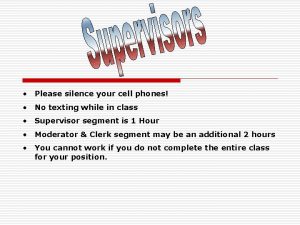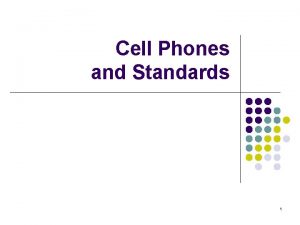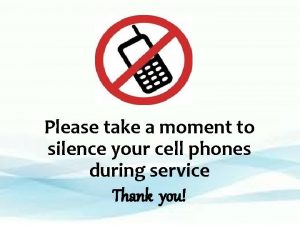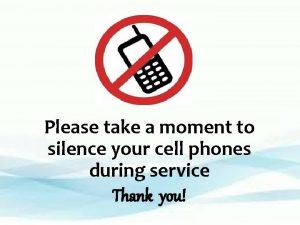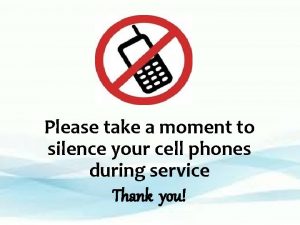Welcome Please silence your cell phones 1 Volunteer























- Slides: 23

Welcome! Please silence your cell phones. 1

Volunteer Storyteller Training Session 2 Date: Trainer: 2

Session 2 Objectives n n n Practice telling a 2 -minute fable. Reflect on your storytelling and offer comments for other tellers. Review a variety of ways to learn a story and to make it your own. Identify resources for finding stories and building a repertoire. Recognize age-appropriate stories. Identify best practices in story mechanics: introductions, strong starts/effective endings, voice and gestures. 3

Session 2 Agenda Guest Teller Offering appreciations and critique Practice Telling Learning a story Finding and choosing a story Building a repertoire Story mechanics 4

Guest Teller Listen Watch Learn 5

Let’s Listen, Watch, and Learn n Eye Contact n Enunciation and Pronunciation n Familiarity with Story n Poise n Voice n Volume 6

It’s Your Turn Introduce your story n Tell your story n Offer reflections n 7

Learning a Story Reflect on your experience of learning a story. n How did you learn the fable? n What was easy/natural for you? n What seemed to be a challenge? 8

Learning a Story n n n n Read or listen again and again Identify the Most Important Thing (MIT) Visualize – graphics or drawings Audio Tape Know the characters Identify the elements of story Mac. Donald’s – A story in 1 hour Practice, Practice 9

Learning a Story Techniques for visualizing with graphics: n Story Outline n Story Board n Story Circles 10

Take a Break and a Breath 11

Finding and Choosing Stories RULE #1: Choose stories you LOVE! n Resources Library q Spellbinders® Newsletter q Training materials q Other storytellers and chapter leaders q Internet with caution! q n No personal stories, please 12

Finding and Choosing Stories RULE #1: Choose stories you LOVE! n Consider the grade, age, and profile of audience Vocabulary q Topic or theme q Cultural diversity q 13

Building a Repertoire n n Retell and Revise Create a system for cataloging YOUR stories q q q n n n Card file Folders Story logs or record forms Categorize stories for ages, seasons, topics etc. Respect Copyright/Always Give Credit Maintain an “Idea File” 14

The Mechanics of Storytelling Introducing a story n Strong Starts n Effective Endings n Voice n Gestures n Poise n 15

Mechanics of Storytelling Introducing a Story n n Prepare your audience for the story Background/Factual Info q q q n n Why you chose this story Appropriateness to season, theme, etc. Country of origin (find on map) THIS IS MY STORY Apply the K. I. S. S. Principle Pause before staring the story 16

Mechanics of Storytelling Strong Starts & Effective Endings n Strong Starts q q n Effective Endings q q n Opening Line(s)=Transition into “world of story” Grab listeners’ attention; arouse curiosity “Once Upon A Time” Ask a question Audience KNOWS story is over! Punch line; ties it all together EXPERIMENT ONCE UPON A TIME…

Mechanics of Storytelling Gestures n n There’s no one right way Only use gestures that are natural for you The purpose of gesturing is to enhance meaning Ask for feedback 18

Mechanics of Storytelling Voice and Poise n Only use different character voices that are comfortable for you n Breathing makes for excellent voice n Volume is important n Be yourself while considering your audience 19

Homework n Review Study Notes #5, #6, #7, #8 n Select, learn, practice and be prepared to tell a 4 -minute folk tale, fable or other story without notes. Prepare a brief introduction for the story and give the source. n 20

Session 2 Objectives Look Again n Practice telling a 2 -minute fable. n n Reflect on your storytelling and offer comments for other tellers. Review a variety of ways to learn a story and to make it your own. Identify resources for finding stories and building a repertoire. Recognize age-appropriate stories. Identify best practices in story mechanics: introductions, strong starts/effective endings, voice and gestures. 21

How’d we do? Take a moment to write: n 3 things you learned n 2 things you want to know more about n 1 thing you’ll try tomorrow 22

Thank You n Thank you for coming n Check your email n Questions are welcome n See you next time 23
 Please silence your cell phone announcement
Please silence your cell phone announcement Define polyamorous
Define polyamorous Please silence your phone
Please silence your phone Please silence your mobile
Please silence your mobile Silence silence un souffle descend partition pdf
Silence silence un souffle descend partition pdf Welcome phones
Welcome phones Please observe silence
Please observe silence Please extend your warm welcome
Please extend your warm welcome When did cell phones come out
When did cell phones come out Elephants get cell phones achieve3000 answers
Elephants get cell phones achieve3000 answers Axes paragraph structure
Axes paragraph structure Personification poems about cell phones
Personification poems about cell phones Please turn off your cell phone in church
Please turn off your cell phone in church Please turn off your cell phone announcement
Please turn off your cell phone announcement Will you please be quiet please summary
Will you please be quiet please summary Welcome please take a seat
Welcome please take a seat Welcome please sign in
Welcome please sign in Wise men three clever are we
Wise men three clever are we Input devices of mobile phones
Input devices of mobile phones Samsung sweatshops
Samsung sweatshops Rhetorical question
Rhetorical question Mobile phones in montclair
Mobile phones in montclair History of android phones
History of android phones Tesco cordless phones
Tesco cordless phones
